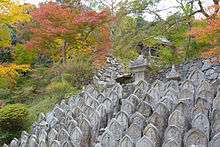Shōryaku-ji
Shōryaku-ji (正暦寺) is a Shingon temple in the southeast of Nara, Japan. Founded in 992, it is the head temple of the Bodaisen Shingon sect.[1]
| Shōryaku-ji | |
|---|---|
正暦寺 | |
 | |
| Religion | |
| Affiliation | Bodaisen Shingon |
| Deity | Yakushi Nyorai |
| Location | |
| Location | 157 Bodaisen-chō, Nara, Nara Prefecture |
| Country | Japan |
| Architecture | |
| Founder | Kenshun |
| Completed | 992 |
| Website | |
| http://shoryakuji.jp/index.html | |
History
Shōryaku-ji is said to have been founded by Kenshun (兼俊), son of Fujiwara no Kaneie, in 992, at the behest of Emperor Ichijō. The temple burned to the ground in the 1180 assault on Nara by Taira no Shigehira. Revived the following century, Shōryaku-ji fell into decline in the Edo period and most of the buildings of the garan have been lost.[1]
Buildings
The Hondō and Shōrō are from the Taishō period (1916 and 1925 respectively). The sukiya-style reception hall from Enpō 9 (1681) is an Important Cultural Property.[2][3][4]
Treasures
The honzon, a gilt bronze Yakushi Nyorai of the Asuka period, is a hibutsu. It has been designated an Important Cultural Property, alongside a Southern Song celadon bowl excavated from the precinct, and scroll thirty from a Nara-period Ekottara Agama, known as Zenkō-shuin-kyō (善光朱印経) or sutras with the red seal of Zenkō, now kept at Nara National Museum.[4][5][6] A Kamakura-period Nirvana painting and a pair of scrolls with an Ise Mandala of the Nanboku-chō period are Prefectural Cultural Properties, as are two standing wooden Heian-period bodhisattvas traditionally identified as having come originally from Daigorin-ji (大御輪寺), and a Kamakura-period sculpture of Kujaku Myōō.[6][7] A Kamakura-period scroll of Yakushi and the Twelve Heavenly Generals is a Municipal Cultural Property and is kept at Nara National Museum.[8]
Flora
The temple's Japanese Chinquapin forest is a Prefectural Natural Monument.[7]
See also
- For an explanation of terms concerning Japanese Buddhism, Japanese Buddhist art, and Japanese Buddhist temple architecture, see the Glossary of Japanese Buddhism.
References
- 正暦寺ご案内 [Guide to Shōryakuji] (in Japanese). Shōryakuji. Retrieved 29 November 2015.
- 正暦寺本堂・鐘楼 [Shōryakuji Hondō - Shōrō] (in Japanese). Shōryakuji. Retrieved 29 November 2015.
- 福寿院客殿 [Fukuju-in Kyakuden] (in Japanese). Shōryakuji. Retrieved 29 November 2015.
- 国指定文化財一覧 [List of National Cultural Properties] (in Japanese). Nara Prefecture. Retrieved 29 November 2015.
- 金銅薬師如来倚像 [Seated Wooden Statue of Yakushi Nyorai] (in Japanese). Agency for Cultural Affairs. Retrieved 29 November 2015.
- 正暦寺の文化財 [Cultural Properties of Shoryakuji] (in Japanese). Shōryakuji. Retrieved 29 November 2015.
- 奈良県指定文化財一覧 [List of Prefectural Cultural Properties of Nara Prefecture] (PDF) (in Japanese). Nara Prefecture. 1 April 2015. Retrieved 29 November 2015.
- 奈良市指定文化財一覧 [List of Municipal Cultural Properties] (in Japanese). Nara City. Retrieved 29 November 2015.